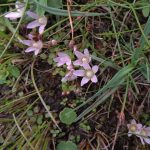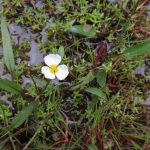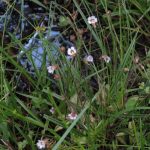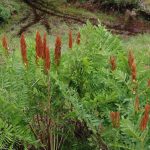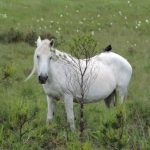The annual coach trip took place to the New Forest on 18th June and was led by Renée Grayer. Our previous trips to the same locations had been a month later, so that we saw different plants in flower this time. We were lucky with the weather as it was dry after a wet week, with a pleasant temperature. Only 19 members were on the coach, but five more joined us at Hatchet Pond, our first stop. Even the bog in the car park is a botanical hotspot, so that we spent a happy half an hour exploring the plants. There was a good display of flowering Bog Pimpernel (Anagallis tenella), Lesser Spearwort (Ranunculus flammula), Tormentil (Potentilla erecta), Tufted Forget-me-not (Myosotis laxa), Lousewort (Pedicularis sylvatica) and the rare Slender Marsh-bedstraw (Galium constrictum), while the soil was covered with the round leaves of Marsh Pennywort (Hydrocotyle vulgaris), but unfortunately also with the invasive New Zealand Pygmyweed (Crassula helmsii). We were delighted to see several flowers of the rare Lesser Water-plantain (Baldellia ranunculoides) and two flowers of Marsh Speedwell (Veronica scutellata). Both the Round-leaved and Oblong-leaved Sundews (Drosera rotundifolia and D. intermedia) were in bud, and a tiny plant was identified as Allseed, Radiola linoides. Walking around the main lake, large areas of the very rare Hampshire-purslane (Ludwigia palustris) were noted, and also of Bogbean (Menyanthes trifoliata) and White Water-lily (Nymphaea alba). In ditches along the lake we saw the light pink flowers of Pale Butterwort, Pinguicula lusitanica, an insect-eating plant, surrounded by also insect-eating Sundews. Going back towards the car park area, we crossed the road to visit a small pond, where we had found many rare plants around the margins during previous visits, but which we did not see this time, presumably because of the high water level caused by heavy rain during the previous days. But in the drier areas we found Trailing and Marsh St John’s-wort (Hypericum humifusum and H. elodes), Bog Myrtle (Myrica gale), more Hampshire-purslane, Lousewort, Bog Pimpernel, Marsh Pennywort, Tormentil and Allseed, Heath Speedwell (Veronica officinalis), some specimens with the usual lilac flowers but others with purple-blue petals, Bell Heather (Erica cinerea) and Royal Fern (Osmunda regalis). During our lunch with views onto the lake, we heard the songs of Willow Warbler and Chiffchaff and saw several Oyster Catchers.
After lunch the coach drove us to a car park close to Beaulieu Road Station, and there we took the right hand footpath towards a wood in the distance. The vegetation was rather monotonous at the start of our walk, as non-flowering Heather (Calluna vulgaris) dominated. Gorse in this area had recently been removed. In the distance, on a solitary dead tree, a Peregrine Falcon (Falco peregrinus) perched. A bridge led over a boggy area, where Common Cottongrass (Eriophorum angustifolium), Marsh St John’s-wort, Tormentil, Round-leaved Sundew, Bog Myrtle, Bog Pondweed (Potamogeton polygonifolium) and Cross-leaved Heath (Erica tetralix) were growing. An area with Bracken (Pteridium aquilinum) followed, in which fruiting Wild Gladiolus (Gladiolus illyricus) had been discovered during previous trips. This species is very difficult to spot as it grows underneath Bracken, but fortunately we did find one specimen, still in bud. A wood beyond revealed Foxglove (Digitalis purpurea) and Wood Spurge (Euphorbia amygdaloides), and another bog Water-purslane (Lythrum portula), Bog Stitchwort (Stellaria alsine), Pill Sedge (Carex pilulifera) and many specimens of Heath Spotted-Orchid (Dactylorhiza maculata). Lesser Spearwort, Cuckooflower (Cardamine pratensis) and the rare New Forest Crowfoot (Ranunculus x novae-forestae) were seen in a further bog, and Yellow Pimpernel (Lysimachia nemorum), Wood-sorrel (Oxalis acetosella), Butcher’s-broom (Ruscus aculeatus) and Pignut (Conopodium majus) in a wooded area. A different path completed the circular walk and when the carpark and coach were in sight, the tiny Bird’s-foot (Ornithopus perpusillus) was spotted.
Report by Renée Grayer
Pictures by Rob Stallard

